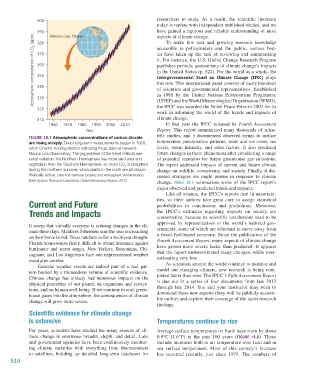Page 511 - Environment: The Science Behind the Stories
P. 511
400 researchers to study. As a result, the scientific literature
today is replete with independent published studies, and we
390 Mauna Loa, Hawaii have gained a rigorous and reliable understanding of most
Atmospheric concentration of CO 2 (ppm) 370 ies have taken up the task of reviewing and summarizing
aspects of climate change.
To make this vast and growing research knowledge
380
accessible to policymakers and the public, various bod-
it. For instance, the U.S. Global Change Research Program
360
publishes periodic assessments of climate change’s impacts
in the United States (p. 522). For the world as a whole, the
350
Intergovernmental Panel on Climate Change (IPCC) plays
this role. This international panel consists of many hundreds
340
of scientists and governmental representatives. Established
330
(UNEP) and the World Meteorological Organization (WMO),
the IPCC was awarded the Nobel Peace Prize in 2007 for its
320 in 1988 by the United Nations Environment Programme
work in informing the world of the trends and impacts of
310 climate change.
1960 1970 1980 1990 2000 2010 In that year the IPCC released its Fourth Assessment
Year Report. This report summarized many thousands of scien-
Figure 18.7 Atmospheric concentrations of carbon dioxide tific studies, and it documented observed trends in surface
are rising steeply. Direct long-term measurements began in 1958, temperature, precipitation patterns, snow and ice cover, sea
when Charles Keeling started collecting these data at Hawaii’s levels, storm intensity, and other factors. It also predicted
Mauna Loa Observatory. The jaggedness of the trend reflects sea- future changes in these phenomena after considering a range
sonal variation: the Northern Hemisphere has more land area and of potential scenarios for future greenhouse gas emissions.
vegetation than the Southern Hemisphere, so more CO is absorbed The report addressed impacts of current and future climate
2
during the northern summer, when plants in the north are photosyn- change on wildlife, ecosystems, and society. Finally, it dis-
thetically active. Data from National Oceanic and Atmospheric Administration, cussed strategies we might pursue in response to climate
Earth System Research Laboratory, Global Monitoring Division, 2013.
change. Table 18.2 summarizes some of the IPCC report’s
major observed and predicted trends and impacts.
Like all science, the IPCC’s reports deal in uncertain-
Current and Future ties, so their authors take great care to assign statistical
probabilities to conclusions and predictions. Moreover,
Trends and Impacts the IPCC’s estimates regarding impacts on society are
conservative, because its scientific conclusions need to be
approved by representatives of the world’s national gov-
It seems that virtually everyone is noticing changes in the cli-
mate these days. Maldives fishermen note the seas encroaching ernments, some of which are reluctant to move away from
on their home island. Texas ranchers suffer a multiyear drought. a fossil-fuel-based economy. Since the publication of the
Florida homeowners find it difficult to obtain insurance against Fourth Assessment Report, many aspects of climate change
hurricanes and storm surges. New Yorkers, Bostonians, Chi- have grown more severe faster than predicted. It appears
cagoans, and Los Angelenos face one unprecedented weather that the report underestimated many changes, while over-
event after another. estimating very few.
Extreme weather events are indeed part of a real pat- As scientists around the world continue to monitor and
tern backed by a tremendous volume of scientific evidence. model our changing climate, new research is being com-
Climate change has already had numerous impacts on the pleted faster than ever. The IPCC’s Fifth Assessment Report
physical properties of our planet, on organisms and ecosys- is due out in a series of four documents from late 2013
tems, and on human well-being. If we continue to emit green- through late 2014. You and your instructor may wish to
house gases into the atmosphere, the consequences of climate download these new reports (they will be publicly accessi-
change will grow more severe. ble online) and explore their coverage of the latest research
findings.
Scientific evidence for climate change
is extensive Temperatures continue to rise
For years, scientists have studied the many aspects of cli- Average surface temperatures on Earth have risen by about
mate change in enormous breadth, depth, and detail. Labs 0.9°C (1.6°F) in the past 100 years (Figure 18.8). These
and government agencies have been continuously monitor- include increases both in air temperature over land and in
ing climate variables with everything from thermometers sea surface temperature. Most of this century’s increase
to satellites, building up detailed long-term databases for has occurred recently, just since 1975. The numbers of
510
M18_WITH7428_05_SE_C18.indd 510 12/12/14 4:05 PM

